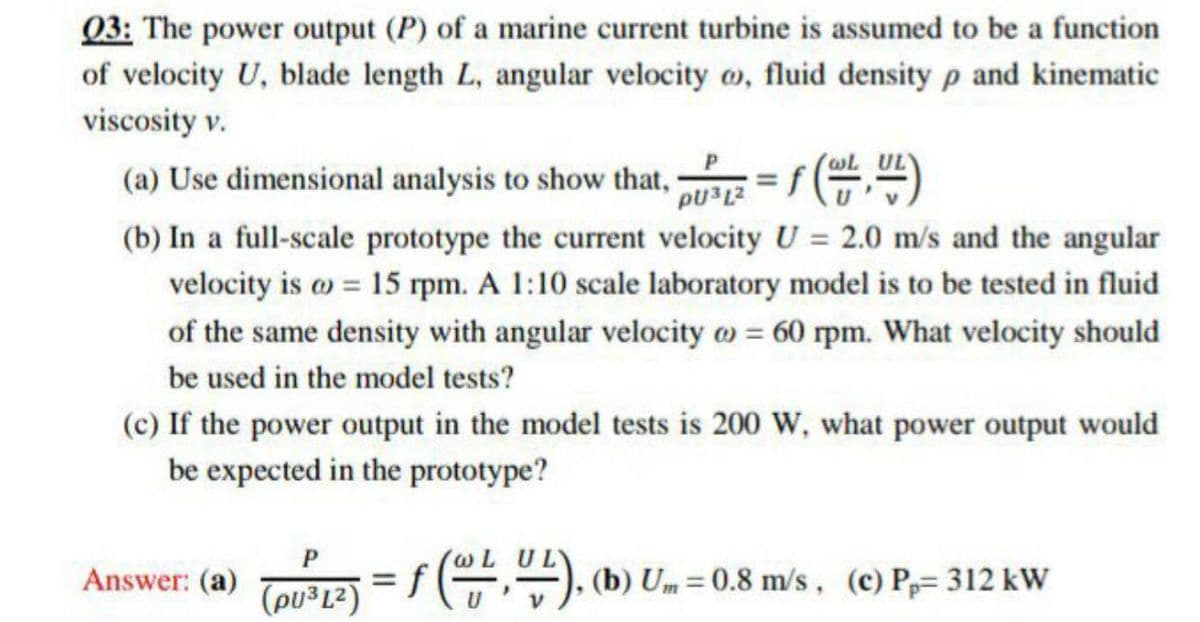Q3: The power output (P) of a marine current turbine is assumed to be a function of velocity U, blade length L, angular velocity o, fluid density p and kinematic viscosity v. (a) Use dimensional analysis to show that, - (b) In a full-scale prototype the current velocity U = 2.0 m/s and the angular velocity is o = 15 rpm. A 1:10 scale laboratory model is to be tested in fluid of the same density with angular velocity w = 60 rpm. What velocity should be used in the model tests? (c) If the power output in the model tests is 200 W, what power output would be expected in the prototype? Answer: (a) fE), (b) Um=0.8 m/s, (c) Pp= 312 kW %3D (pu³L2)
Q3: The power output (P) of a marine current turbine is assumed to be a function of velocity U, blade length L, angular velocity o, fluid density p and kinematic viscosity v. (a) Use dimensional analysis to show that, - (b) In a full-scale prototype the current velocity U = 2.0 m/s and the angular velocity is o = 15 rpm. A 1:10 scale laboratory model is to be tested in fluid of the same density with angular velocity w = 60 rpm. What velocity should be used in the model tests? (c) If the power output in the model tests is 200 W, what power output would be expected in the prototype? Answer: (a) fE), (b) Um=0.8 m/s, (c) Pp= 312 kW %3D (pu³L2)
Elements Of Electromagnetics
7th Edition
ISBN:9780190698614
Author:Sadiku, Matthew N. O.
Publisher:Sadiku, Matthew N. O.
ChapterMA: Math Assessment
Section: Chapter Questions
Problem 1.1MA
Related questions
Question

Transcribed Image Text:Q3: The power output (P) of a marine current turbine is assumed to be a function
of velocity U, blade length L, angular velocity o, fluid density p and kinematic
viscosity v.
(a) Use dimensional analysis to show that, = f (,)
(b) In a full-scale prototype the current velocity U = 2.0 m/s and the angular
velocity is o = 15 rpm. A 1:10 scale laboratory model is to be tested in fluid
of the same density with angular velocity o = 60 rpm. What velocity should
be used in the model tests?
(c) If the power output in the model tests is 200 W, what power output would
be expected in the prototype?
Answer: (a) Tors12) =
(pu³L²)
f,"). (b) Um = 0.8 m/s , (c) P,= 312 kW
Expert Solution
This question has been solved!
Explore an expertly crafted, step-by-step solution for a thorough understanding of key concepts.
Step by step
Solved in 4 steps with 4 images

Knowledge Booster
Learn more about
Need a deep-dive on the concept behind this application? Look no further. Learn more about this topic, mechanical-engineering and related others by exploring similar questions and additional content below.Recommended textbooks for you

Elements Of Electromagnetics
Mechanical Engineering
ISBN:
9780190698614
Author:
Sadiku, Matthew N. O.
Publisher:
Oxford University Press

Mechanics of Materials (10th Edition)
Mechanical Engineering
ISBN:
9780134319650
Author:
Russell C. Hibbeler
Publisher:
PEARSON

Thermodynamics: An Engineering Approach
Mechanical Engineering
ISBN:
9781259822674
Author:
Yunus A. Cengel Dr., Michael A. Boles
Publisher:
McGraw-Hill Education

Elements Of Electromagnetics
Mechanical Engineering
ISBN:
9780190698614
Author:
Sadiku, Matthew N. O.
Publisher:
Oxford University Press

Mechanics of Materials (10th Edition)
Mechanical Engineering
ISBN:
9780134319650
Author:
Russell C. Hibbeler
Publisher:
PEARSON

Thermodynamics: An Engineering Approach
Mechanical Engineering
ISBN:
9781259822674
Author:
Yunus A. Cengel Dr., Michael A. Boles
Publisher:
McGraw-Hill Education

Control Systems Engineering
Mechanical Engineering
ISBN:
9781118170519
Author:
Norman S. Nise
Publisher:
WILEY

Mechanics of Materials (MindTap Course List)
Mechanical Engineering
ISBN:
9781337093347
Author:
Barry J. Goodno, James M. Gere
Publisher:
Cengage Learning

Engineering Mechanics: Statics
Mechanical Engineering
ISBN:
9781118807330
Author:
James L. Meriam, L. G. Kraige, J. N. Bolton
Publisher:
WILEY